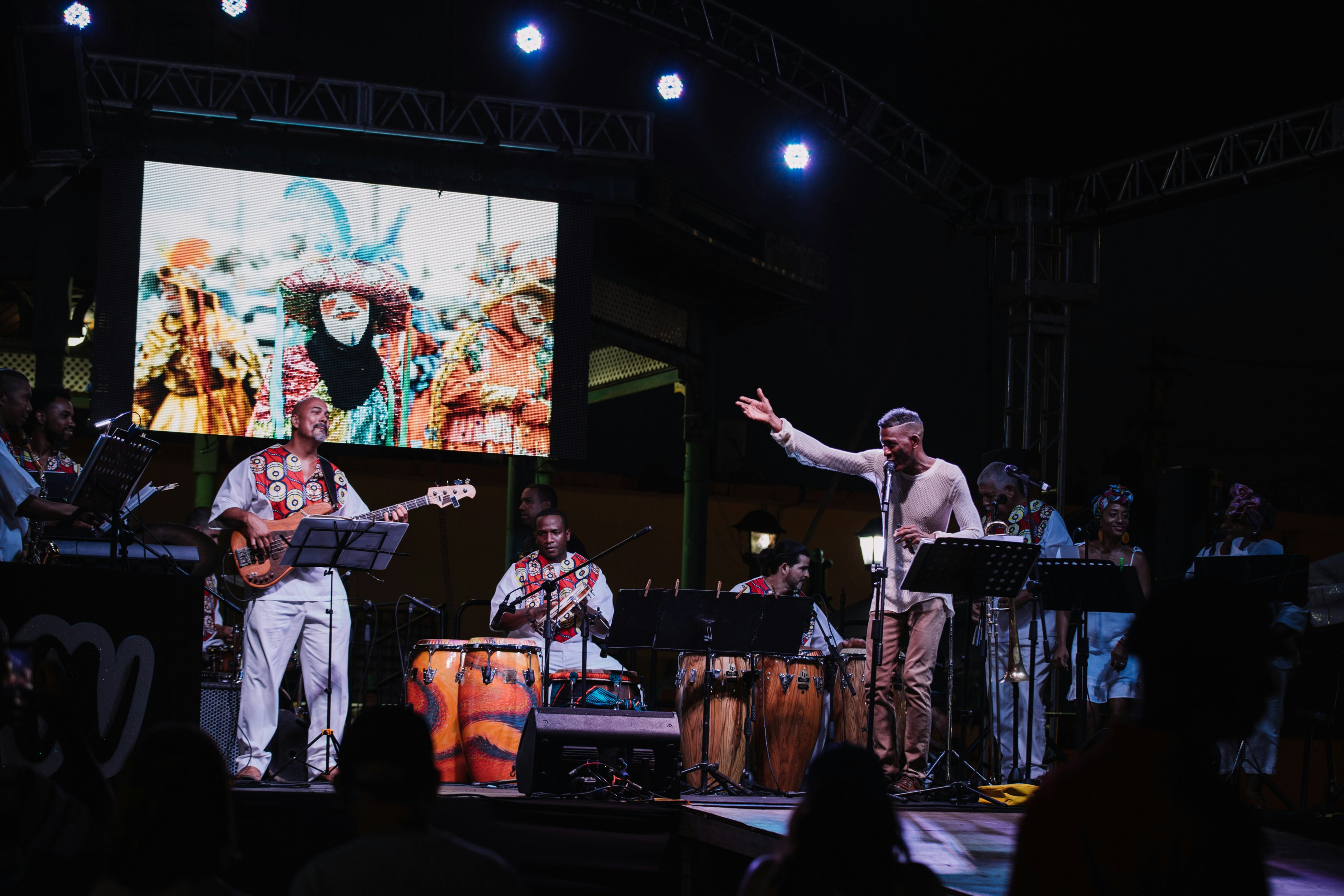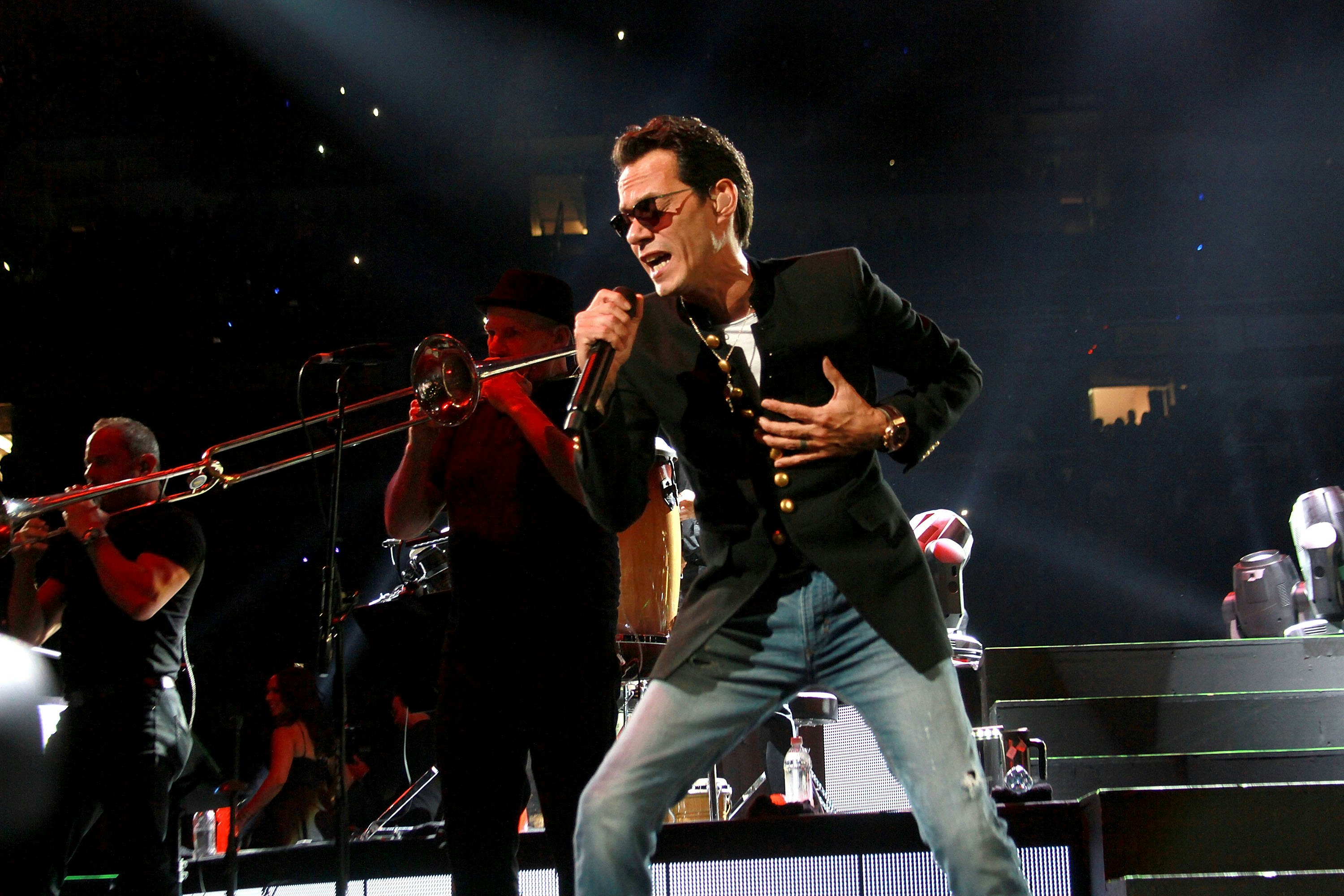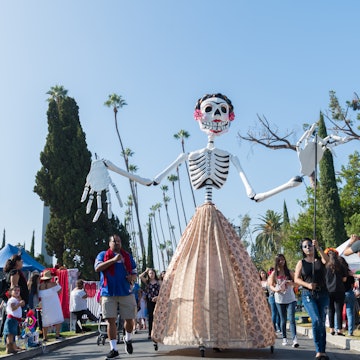
How salsa, bomba and reggaeton shaped Puerto Rico's culture – and where to hear them

Jan 10, 2022 • 11 min read

So many moments in Puerto Rican life are punctuated with music © Lyma Rodrigués / Discover Puerto Rico
For centuries, Puerto Ricans have been marching to the beat of their own drum. From busy markets to schoolyards, restaurants, colmados (grocery stores), funerals and bass-bumping cars passing by – there isn’t a moment in Puerto Rico that isn’t punctuated by a musical melange.
Homegrown genres like reggaeton and salsa dominate the radio airwaves and attract thousands of revelers to improvised dance floors and outdoor bars night after night, while traditional genres like bomba and plena offer a gateway into the idiosyncrasies and history that define the Puerto Rican experience.

Salsa is in the blood
Though the origins of the name salsa have been disputed among academics and fans since the sound came into popularity, the music’s roots go as far back as the 1930s and 1940s in Cuba, with the development of one of its premier cultural exports – the son montuno (mountain sound). When US diplomatic relations with Cuba were still open, son montuno migrated to New York City along with the movement of other Spanish Caribbean peoples, including Puerto Ricans, Dominicans and Cubans.
Salsa exploded in the US in the late 1960s and throughout the 70s in the Caribbean medley that was New York City. Bands formed mainly of Latinos like Celia Cruz, Rubén Blades, Johnny Pacheco, Machito and Héctor Lavoe became popular household names thanks largely to the creation of the Fania record company.
The salsa sound
Salsa has always maintained its Cuban roots when it comes to instrumentation – ever-present are the bongos, congas and timbales – but Puerto Rican musicians added more traditional elements, such as the infusion of bomba and plena, danza (a traditional ballroom genre derived from Spanish influence), and música jíbara, a type of folk music that originated in Puerto Rico's mountainous region.
In its essence, Puerto Rican salsa is a representation of the Puerto Rico-NYC emigration pipeline, with artists like Lavoe, Bobby Valentín and the Lebrón Brothers bringing their style to the island.

But home-grown musicians helped develop Puerto Rican salsa as well. Rafael Cortijo y Su Combo rose to prominence in the 1950s with their experimental infusion of guaracha, another fast-paced genre that developed in Cuba, and songs about social issues like racism and poverty. You can hear this in a song like “Mataron al Negro Bembón”.
While there was a sonic evolution of salsa from the 50s to the 90s, the genre, at least in Puerto Rico, has stagnated a bit and remained mostly in its last incarnation, salsa romantica – a sound punctuated by slower melodies and lyrics about love gone wrong.
However, salsa dura – a sound that originated in NYC that emphasizes instrumentation like the piano, horns, bass and percussion – can be heard from loudspeakers in colmados all around the island, and in bars like El Boricua in Río Piedras, La Factoria in Old San Juan and the spots Mijani and Taberna Los Vázques in the Placita de Santurce, which was founded more than 100 years ago as an outdoor market.

Best places to hear salsa
Your best bet to find live orchestras and bands playing salsa is to visit hotel lobbies in San Juan, like the Embassy Suites Hotel & Casino and the renovated Fairmont San Juan Hotel which has an amazing musical history and keeps its original 1960s-style lobby and a live cabaret. As is custom for locals on a night out on the town, be ready with formal wear and dancing shoes when going to these hotels.
For a more casual hang, head over to Taberna Los Vázques in the Placita de Santurce, an open-air market that also serves food, and usually has salsa from Friday to Sunday.
Inside La Factoría in Old San Juan you can dance salsa at their secret bar, Shing-a-Ling, which hosts La 51 salsa band on Sundays and Mondays. El Boricua in Río Piedras also has a ton of salsa in their jukebox, along with a dancefloor, where you can find sweaty partners passionately dancing the night away any day of the week.
Feeling more adventurous? Check out some of the new salsa orchestras like Orquesta El Macabeo and Pirulo y La Tribu, or plan your trip around the Día Nacional de la Zalsa an event hosted yearly by the premiere salsa station on the island, Z93.

Keeping the bomba tradition alive
According to Folkways Recordings – a branch of the Smithsonian Museum, bomba dates back to the early Spanish colonial period on the island. It's music born out of the transatlantic slave trade and formed out of the distinct musical traditions enslaved Africans brought with them to Puerto Rico in the 17th century.
The music is communal, with drummers playing the subidor or primo (barrel drums) and the singer playing the cuá (smaller drum played with wooden sticks) and the maracas. The circle formation the drummers play in is called the batey or soberao.
Highly-skilled dancers dressed in a traditional, heavy white cotton skirt or, if it’s a man, a guayabera shirt and slacks, are usually invited to the middle of the circle to make the piquete – footwork that directs the drummer’s beat.
Much like in the 17th century, bomba lyrics today are highly political. To the enslaved, bomba music was a source of political and spiritual expression.

The lyrics convey a sense of anger and sadness about what the enslaved people endured. The songs themselves “served as a catalyst for rebellions and uprisings,” Folkways writes. Today, bomba is both an indictment of sociopolitical conditions and a celebration of life on the island.
Where to go to see bomba
Bomba can be heard almost anywhere there’s nightlife, but live drummers and dancers can be experienced weekly at La Terraza de Bonanza in Santurce, El Boricua in Río Piedras and La Vergüenza in Old San Juan on Sundays. All of the venues feature outdoor spaces. Locals tend to spill onto the street for fresh air or for more room to dance.
The vibe is pretty rowdy and noisy, and people tend to go to these places after work, so you’ll get a variety of dress codes. Opt for casual with comfortable shoes and breathable clothes – it's likely to get very hot.

Those looking for bomba dance lessons can always visit the legendary Don Rafael Cepeda School of Bomba and Plena and El Batey de los Hermanos Ayala.
To get a fuller appreciation of bomba, head to the town of Loíza Aldea for Las Fiestas de Santiago Apóstol, an annual celebration held at the end of July that celebrates the rich bomba and Afro-Puerto Rican culture. Hear from two of the great bomba families (the Cepedas and the Ayalas) who are responsible for keeping the tradition alive and educating younger Puerto Ricans in the art.
Plena: El Periódico Cantao’
Plena is a uniquely Puerto Rican genre developed from the sounds of bomba in the early 20th century. It features one rhythmic current played with three panderos (an instrument similar to the tambourine but without the metallic cymbals): the requinto, seguidor and punteador, all instruments autochthonous to Puerto Rico, and not to be confused with Spanish string instruments. Like bomba, it's heavily percussion-based.
European instrumentation like Spanish guitars and accordions have been added from time to time, but these are mostly experimentations, and you’d be hard-pressed to find pleneros currently using them.

The major hubs for plena are Ponce, Mayagüez and the barrio of Santurce in San Juan.
Best places to go to hear plena
While you can listen to plena in most of the same places in bars like El Boricua, La Vergüenza Puerto Rican Chinchorro and La Terraza de Bonanza, one of the biggest gatherings of pleneros takes place yearly at the Fiestas de la Calle San Sebastián.
There, pleneros from all over the island get together on the street corners of Old San Juan and teach each other the traditional coros (choirs) of their regions and share history.
Since plena lyrics are mostly kept through oral tradition, these gatherings keep the genre alive and help new generations of musicians learn the styles from all over the island while preserving the music for future generations.
Reggaeton's global impact
Reggaeton is a genre born out of the island's streets in the early 1990s. Its lyrics encapsulate the young, urban and Afro-Puerto Rican experience, social justice, sexuality and a fight for legitimacy in the cultural canon.
Its origins are rooted in the Jamaican migration to Panama and the Panamanian reggae en Español fusion. Panamanian artist El General is known as the father of the genre.
When the sound reached Puerto Rico, musicians and DJs quickly departed from reggae en Español, which was just Jamaican reggae songs translated into Spanish, and created something of their own.
Reggaeton incorporates Jamaica's dancehall "riddim" (or instrumental track) with the heavy percussion beat present in all Puerto Rican music with fresh lyrics laid on top.

Daddy Yankee, DJ Nelson, DJ Negro, Ivy Queen, La Sista, and the supergroup The Noise spearheaded reggaeton in the underground scene on the island and, eventually, exported it throughout the US and Latin America.
The mid-90s saw reggaeton, along with its performers and fans, become vilified by the Puerto Rican government. Police raided underground parties, clubs, record stores and concert venues, citing concerns about morality, obscene language, drug and weapons trafficking and explicit sexuality.
The raids, part of a police operation called Mano Dura Contra el Crímen, served to turn public opinion against the genre and demonize its artists and fans. While the stigma continues to this day, specifically among older generations, reggaeton’s crossover into the global market has made the music ubiquitous on the island, and one of Puerto Rico’s most famous cultural exports.
Where you can hear Reggaeton
You don’t have to go far to hear to reggaeton – you’ll likely be greeted by a passing car blasting the style from its sound system, in neighboring houses and in the beloved chinchorros (small snack shack) all around the island.
For a club vibe, head over to Piso Viejo in Calle Loíza or Aguardiente in Santurce. You can also listen to new, LGBTIQ+ reggaeton and trap artists like Villano Antillano in queer-friendly clubs.

Pop hits in Puerto Rico
Without a doubt, reggaeton is one of the country's most popular and exported genres, but pop music has also created waves globally.
The pop explosion on the island began during the mid-1960s and 70s, with cultural critic Alfred D. Herger introducing audiences to the newest sounds and top hits from the world’s music charts on his TV shows Teenager’s Matinee and Canta la Juventud.
Both shows started the careers of pop icons like Lucecita Benítez and Chucho Avellanet and opened the floodgates for the development of big pop artists during the 80s like Menudo, Chayanne and Ednita Nazario.
Best places to hear pop
Artists like Ricky Martin, Bad Bunny, JLo, Kany García, Pedro Capó and Marc Anthony are responsible for Puerto Rican pop's mass appeal. And today, you can hear their music and other top hits in nightclubs and bars like Brava, La Respuesta and El Local.
Brava is a nightclub at the Fairmont San Juan Hotel, and it’s usually high-end, so dress to impress as you party until dawn. Places like Brava usually have dress codes, so they might not allow tennis shoes or super casual street clothes.
El Local and La Respuesta are super chill about dress codes and are low-key hangouts, so go as you are and be ready to have some fine Medallas, a beloved local beer.

Rock and punk presence on the island
It might be surprising to some, but Puerto Rico also has a big rock and punk scene that's been thriving since the 90s with mid-size venues opening up and booking local and independent acts.
One of the most famous bands to come out of the scene is Dávila 666, with their gritty, urban brand of garage rock. Other bands you’ll likely hear about from any underground rock fan in San Juan are Campo-Formio, Alegría Rampante, Avandra, Moths, Sr. Langosta, Fullminator and Neysa Blay.
There isn’t a unified sound that identifies the rock scene. Just between the bands mentioned above, you'll find hardcore punk, pop-rock, metal, prog rock and jazz-rock fusion.
Best places to hear rock
San Juan venues like La Respuesta and Club 77 have become renowned for hosting some of these bands and for fostering the independent rock scene. Recently, both venues have been embroiled in sexual harassment accusations and claims of unsafe environments. Both venues have addressed and denied the claims. You can read La Respuesta’s statement here.
You might also like:
The best things to do in Puerto Rico
How to travel sustainably in Puerto Rico
Beaches, rum and nature: the 9 best places to visit in Puerto Rico
Puerto Rico is on our 2022 Best in Travel list. For more stories from some of the world’s most exciting destinations click here.
Safety recommendations and restrictions during a pandemic can change rapidly. Lonely Planet recommends that travelers always check with local authorities for up-to-date guidance before traveling during Covid-19.













